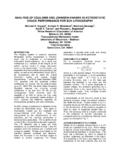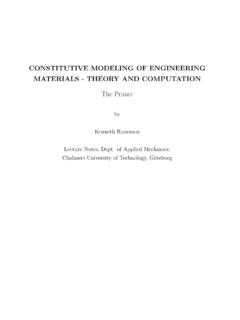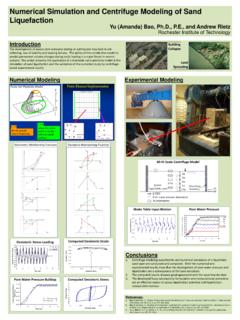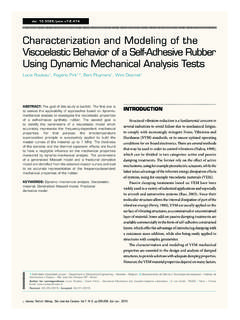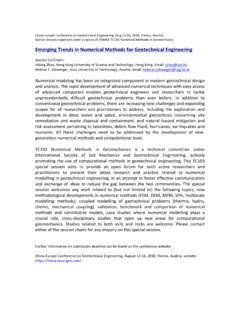Transcription of FUNDAMENTALS OF FRICTION MODELING
1 FUNDAMENTALS OF FRICTION MODELING Farid Al-Bender1 1 Department of Mechanical engineering , Division PMA Katholieke Universiteit Leuven Leuven, Belgium INTRODUCTION FRICTION MODELING has been steadily gaining in interest over the last few decades. However, owing to the complexity of the FRICTION phenomenon, no comprehensive, practicable FRICTION model that shows all of the experimentally observed aspects of FRICTION force dynamics in one formulation is available. Most available FRICTION models are, in essence, empirical, that is, based on limited observations and interpretations. In this sense, the resulting models are valid only for the specific scope of test conditions, such as the level and type of excitation, used to obtain the data.
2 On the other hand, development of simulation models and, where possible, predictive theories, at scales from atomic, through continuum, to useful engineering models, can fill empty gaps in the toolboxes available to designers and analysts. Besides the field of tribology, where the origin of FRICTION is one of the main topics, MODELING and compensation of FRICTION dynamics are treated in several other domains. In the machining and assembly industry, demand for high-accuracy positioning systems and tracking systems is increasing. Research on controlled mechanical systems with FRICTION is motivated by the increasing demand for these systems.
3 FRICTION can severely deteriorate control system performance in the form of higher tracking errors, larger settling times, hunting, and stick-slip phenomena. In short, FRICTION is one of the main players in a wide variety of mechanical systems. This communication presents an overview of FRICTION model-building, which starts from the generic mechanisms behind FRICTION to construct models that simulate observed macroscopic FRICTION behavior. First, basic FRICTION properties are presented. Then, the generic FRICTION model is outlined. Hereafter, simple heuristic/empirical models are discussed, which are suitable for quick simulation and control purposes.
4 An example of these is the Generalized Maxwell-Slip model. FIGURE 1. Basic FRICTION configuration. BASIC FRICTION BEHAVIOR Considering FRICTION as a mechanical system, (see ), a close examination of the sliding process reveals two FRICTION regimes, namely, the pre-sliding regime and the gross sliding regime, (see ). In the pre-sliding regime the adhesive forces, owing to asperity contacts, are dominant, and thus the FRICTION force is primarily a function of displacement rather than velocity. The reason for this behavior is that the asperity junctions deform elasto-plastically, thus behaving as nonlinear hysteretic springs. FIGURE 2.
5 The two FRICTION regimes and the transition between them. x [ ]norm. Ft [ ] FRICTION force (AU) Rate of applied force Transition Gross sliding Displacement (AU) As the displacement increases, more and more junctions break and have less time to reform, resulting eventually in gross sliding. The sliding regime is, thus, characterized by a continuous process of asperity junction formation and breaking such that the FRICTION force becomes predominantly a function of the velocity [1]. The transition from pre-sliding to gross sliding is a criticality that depends on many factors such as the relative velocity (to be envisaged as the displacement rate) and acceleration of the sliding objects, see [2].
6 FIGURE 3. Example of desired motion in the pre-sliding regime. FIGURE 4. Hysteresis behavior as a result of the trajectory of Fig. 3. Pre-sliding behavior At very small displacements, that is, in the pre-sliding regime, experiments reveal a hysteretic displacement-dependent FRICTION force [3,4]. When a pre-sliding displacement command, such as that shown in Fig. 3, is applied to the block, the force-displacement behavior of results. The position signal is chosen such that there is an inner loop within the outer hysteresis loop. The resulting FRICTION -position curve is rate independent (compare the right and left panels of ).
7 In other words, the FRICTION -position curve is independent of the speed of the applied position signal. When an inner loop is closed, (c-d-c), the curve of the outer loop (a-c-b) is followed again, proving the nonlocal memory characteristic of the hysteresis. The shape of the hysteresis function is determined by the distribution of the asperity heights, the tangential stiffness, and the normal stiffness of the contact. This hysteresis behavior arises primarily from micro-slip, that is, the breaking of adhesive contacts, just as in the Maxwell-Slip model discussed further below. The contribution of deformation losses, which are hysteresis losses in the bulk materials, depends on the relative value of this part as compared to the adhesive part, as well as on the tangential stiffness of the asperities, which governs the extent of deformation before slip.
8 FIGURE 5. Characteristics of hysteresis with nonlocal memory. Figure 5 explains the constitution of hysteresis according to Masing s rules. The force-displacement curve initially follows: ( )( );0( )() ;0virginFf xy xxwith f xyxx= = Upon reversal at any point xm , a doubly dialated version of the virgin curve is followed: 22mfricmxxFFf =+ Executed 50 times faster than A Virgin curve 0y(x)-y(-x)xmFfricFm-xm(B) Possible trajectory of the hysteretic FRICTION forcex422135 FIGURE 6. MODELING of hysteresis using Maxwell-Slip elements. This behavior can also be modeled discretely by a parallel connection of Maxwell-Slip elements [5], as shown in Fig.
9 6. Gross sliding When the asperity junctions are continually being created and broken, the frictional interface is in the gross sliding regime. Two main characteristics are of interest here. The first is the steady-state FRICTION force behavior with increasing steady-state sliding velocities, generally known as the Stribeck curve, Fig. 7. The second is the change of the FRICTION force with the velocity variation, known as the FRICTION lag or FRICTION memory phenomenon, Fig. 8. FIGURE 7. The Stribeck curve consists of velocity weakening and velocity strengthening. The Stribeck curve When the FRICTION force is measured at constant velocity values (Fig.)
10 7), the resulting functional relationship has a characteristic form. For increasing velocities, the FRICTION force initially decreases to a minimum (velocity weakening) and then increases again (velocity strengthening). In lubricated sliding, this characteristic is known as the Stribeck curve, where the velocity weakening arises from the initial buildup of hydrodynamic pressure, while the velocity strengthening is attributed to the viscous shear of the lubricating film. The same behavior seems to hold true for dry FRICTION , which justifies using the same name, that is, the Stribeck curve, to describe it. The actual form of the FRICTION -velocity curve is determined by various process parameters, namely, the normal creep or, equivalently, the time evolution of adhesion, the surface topography, and the asperity parameters, primarily the tangential stiffness and inertia [2].
